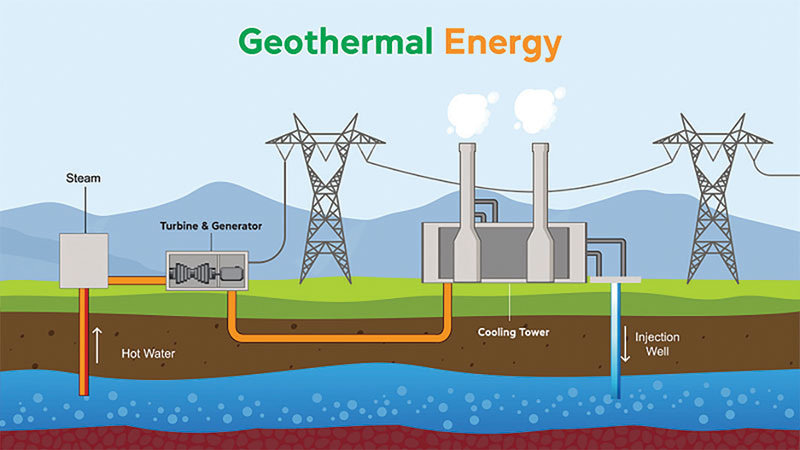Formations of Geothermal Energy
Since the Paleolithic era, geothermal heating has been utilized for space heating and for bathing, respectively, utilizing water from hot springs. Geothermal power, the phrase used to describe the production of electricity from geothermal energy, has become more significant in recent years. Although only a very small portion of the earth’s geothermal energy is now being effectively utilized, frequently in regions close to tectonic plate borders, it is estimated that the earth’s geothermal energy resources are theoretically more than sufficient to meet humanity’s energy needs. The pace at which the Earth’s interior thermal energy is transferred to the surface via conduction is 44.2 terawatts (TW), while the rate at which mineral radioactive decay replenishes it is 30 TW. These power rates are more than twice what mankind now uses in terms of basic energy sources, yet the majority of this energy flow cannot be recovered. The top layer of the surface down to a depth of 10 m (33 ft) is heated by solar energy in the summer and releases that energy and cools in the winter in addition to internal heat flows.
Temperature has a significant impact on the thermal efficiency and economics of power generation. High natural heat flow, especially from employing a hot spring, is best for the most demanding applications. Drilling a well into a hot aquifer is the second-best choice. If there isn’t a suitable natural aquifer nearby, one can be created artificially by injecting water to hydraulically fracture the bedrock. In Europe and North America, this last strategy is known as hot dry rock geothermal energy or enhanced geothermal systems. This method may have far more promise than the traditional method of tapping natural aquifers.
Because the amount of heat extracted is negligible in comparison to the heat content of the Earth, geothermal power is seen as a sustainable, renewable source of energy. Less than 5% of conventional coal-fired plants’ greenhouse gas emissions, or 45 grammes of carbon dioxide on average per kilowatt-hour of energy, are produced by geothermal electric stations. Historically, only on the borders of tectonic plates, where high-temperature geothermal resources are accessible close to the surface, have geothermal electric plants been constructed. The creation of binary cycle power plants and advancements in drilling and extraction methods have allowed for the expansion of geothermal systems across a much wider area.
The heat that has been trapped inside the Earth since the planet’s birth, the radioactive decay of minerals, and solar energy absorbed at the surface are the sources of geothermal energy. The majority of high temperature geothermal heat is extracted from areas where volcanic activity rises close to tectonic plate borders. Ground and groundwater temperatures higher than the application’s target temperature can be found in these places. The temperature of the undisturbed earth is consistently at the Mean Annual Air Temperature below 6 meters (20 feet), and it can be drawn out using a ground source heat pump even while the ground is frigid.
A well is actively injected with water by enhanced geothermal systems so that it can be heated and pumped back out. High pressure water injections are used to widen existing rock cracks so that water can flow freely in and out. The method was modified from methods for extracting oil and gas. There is less chance of environmental harm because the geologic formations are deeper and no harmful chemicals are utilized. To increase the reservoir’s size, drillers can use directional drilling. On geologic timeframes, the globe is steadily cooling because natural heat flows are out of equilibrium. A tiny portion of the natural outflow is tapped by human activity, frequently without accelerating it. Geothermal energy is currently referred to as renewable and sustainable according to the majority of official explanations of its use since it returns an equivalent volume of water to the location where the heat extraction occurs, albeit at a slightly lower temperature. The energy obtained, for instance, is the difference in heat that is taken when water leaves the earth at 300 degrees and returns at 200 degrees.






